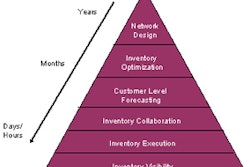The questions in the minds of today's information technology (IT) executives run in a seemingly endless agonizing loop: "Do I have the right infrastructure in place?" "Are my servers and databases and applications doing what they need to do?" "How do I separate valuable new technology from all the junk?"
These are all tough questions. But as any business-minded IT executive knows, these concerns are not about technology alone. They are about technology as it relates to the bottom line, corporate strategy and other business threats, including rising costs, increased competition and ever-slim profit margins. In short, what really keeps the strategic IT executive awake at night is this: "How can I use technology to boost productivity, make the supply chain more efficient, and maximize return on investment?"
Increasingly, IT executives are finding that an often-overlooked and misunderstood application provides the answer. It's easy to implement, helps companies quickly achieve their cost and profit goals, and can give the IT executive the gold star for strategic innovation.
What is this competitive weapon? Voice-directed work. If this hasn't yet made it onto your radar screen, here's a primer to get started.
In the last 20 years, voice-directed work has made significant inroads into the global supply chain. The ability to be voice-directed is freeing up workers and allowing them to be safer, more accurate and more productive on the job.
While distribution center (DC) managers in the grocery and food industries were among the first to embrace voice, word of productivity and accuracy gains through voice quickly spread. As a result, many voice-directed work users are household names from a broad range of industries, including Office Depot, Pep Boys and Pepsi Bottling Group in North America and Norauto, Easydis and Primafrost in Europe.
The ease of use and success of voice-directed work has quickly found adherents in retail, third-party logistics, manufacturing and healthcare companies, as well. Voice has helped organizations maintain "lean" operations, decrease their training costs and reduce the time it takes for workers to become functional in their designated roles. It has proven especially useful for companies that employ seasonal help or have challenges with staff turnover.
Voice-directed work takes the most human approach to communication — two-way dialogue — and literally talks people through their daily tasks. For the supply chain/distribution industry in particular, voice alleviates the strenuous multi-tasking that is typical of work in the DC.
Voice-directed distribution's immediate contribution to more efficient selection, replenishment, put-away, receiving, and other areas has led many of the major grocery distributors to be some of the first adopters, including Kroger and Albertsons in the United States.
How Does Voice Work?
During the course of a typical day in a DC, work files are created by the company's warehouse management system (WMS). In companies without voice, work assignments generated by the WMS are transferred to paper-based systems, radio frequency (RF) scanner-based systems or pick-to-light systems. These systems are labor-intensive, time-consuming, and error-prone — and not all of them can scale as the business grows. But in a voice-enabled DC, the process is much simpler and more accurate.
To understand the importance of voice, it is important to understand the basics of how voice works. It starts with employee assignments, such as put-away, order selection and replenishment tasks that are generated by the company's WMS. Assignments from the WMS are sent via a radio frequency network from the WMS to a lightweight, battery-powered, mobile computer worn by the DC associate.
Once the wearable computer receives the work assignments, they are converted into a series of discrete verbal commands that the worker hears through a lightweight headset. The instructions direct the employee to an aisle/section and slot location. Once there, the employee confirms he or she is at the proper location and completes the task by speaking into the headset.
To complete the transaction, the employee's voice is recognized by the voice recognition software running on the wearable computer, which translates the spoken response into data and sends that data back to the WMS. From there, the WMS issues the next appropriate command and the process repeats itself.
What's the Bottom Line?
By replacing labor-intensive, error-prone systems with more efficient voice-directed work, companies experience increased productivity, increased accuracy, improved worker safety and lower turnover.
Voice increases productivity by making workers more efficient. In DCs utilizing paper labels, hand-held scanning devices and systems requiring the employee to deactivate a lighting mechanism, their attention is frequently being diverted and productivity inevitably drops. Because voice is a hands-free/eyes-free operation, workers can devote total attention to the task at hand, therefore greatly reducing unproductive time and mistakes. In addition, since they are conversing actively with the system, side conversations are virtually eliminated.
Depending on the unique DC environment, typical productivity gains range from 11 to 50 percent or more. These gains can quickly translate into hundreds of thousands of dollars in annual savings. Language barriers, turnover, seasonal fluctuations and the cost of training are a few labor-related issues that often compromise productivity. Because voice accommodates different languages and training time takes just a few hours, companies save significantly on labor costs.
Voice enforces order accuracy through the use of random check digits. The check digits are placed directly at the product's location and must be read when the worker is at that location. Because the voice system won't allow the worker to continue unless he or she reads the appropriate digits, accuracy is guaranteed nearly 100 percent of the time.
Because the employees' hands are free and their eyes are not distracted by having to hold the RF scanner or to look at a piece of paper, they can focus on the critical activities going on around them, which enhances safety. Since the employees' heads are up, they are much more aware of potential dangers.
Voice also results in lower turnover because it allows workers to perform at higher levels with reduced effort. This means they take more pride and ownership in their work. A longer-tenured DC workforce reduces the cost and time waste of turnover and excessive re-training.
When IT executives begin to investigate voice, a number of questions naturally arise. Here are some of the common ones:
- Is voice difficult to implement? Voice-directed work has a tremendous impact on the efficiency of the supply chain and is quite easy to install. It's important to work with a supplier with a strong track record and intimate knowledge of job functions, operating environments, and business realities.
- Is the technology mature enough? Voice-directed work has been successfully deployed by both large and small companies for well over 20 years.
- How do you integrate the WMS with the voice system? A voice deployment requires special software to enable a company's WMS to receive assignments and to establish the two-way dialogue required to give assignments and confirm that tasks are completed. The voice supplier should bring experience across multiple businesses and offer the most effectively engineered combination of hardware and software designed to make using voice as natural and easy as possible. Most major WMS providers already have the necessary interfaces for voice in place. The best voice systems have been designed to integrate directly without middleware to many of the most popular commercial WMS systems. A direct interface can even be implemented for home-grown legacy WMS systems to provide true real-time updates for each activity on the DC floor.
- What security standards are supported by voice? The best voice suppliers support all standards, including Wi-Fi, WPA-PSK and WPA-Enterprise.
- What device management tools are necessary? Since efficient voice systems must manage voice-related configuration information beyond the capabilities of common mobile device management software, full-featured voice systems have device management functionality built in as an integral part of the system.
- Is installing voice similar to implementing a WMS or ERP? No. Voice-directed work can literally be installed in a day, and employee training takes just a few hours.
- What kind of involvement is required from the IT organization? Once the technical interfaces are completed, the requirements from the IT group are minimal. Experienced suppliers know how to take the lead on designing, developing, testing, project managing and implementing voice systems. Furthermore, once it's up and running, there is little overhead associated with ongoing support needs.
- What does the IT infrastructure framework look like? Voice-directed systems interface with a company's existing infrastructure, either via a direct communications interface to the WMS or via middleware. Relevant information is translated into work assignments that are distributed as voice instructions to a body-worn voice device running on the company's existing 802.11b wireless LAN. Integration is straightforward and IT infrastructure impact is minimal.
- Can voice be applied in both centralized and distributed IT environments? Yes. As wide-area networks become faster, more and more companies are looking at centralized systems where only the voice terminal and headsets are in use in the DC and the WMS is centrally located. Experienced voice providers can accommodate this scenario as well as create systems for use in distributed environments.
- What does the overall implementation process look like? Naturally, the installation process will vary depending on the voice supplier selected. You'll want to look for a company whose implementation process has been finely-tuned, based on hundreds of successful installations.
- Can voice systems be customized? Yes. You'll want to look for systems that include an integrated software development tool which allows you to customize your system to meet your specific process and procedures. However, be cautious about voice providers that offer no standard released software and want to develop a fully customized approach for you. This doesn't leverage a voice supplier's R&D investment or allow you to take advantage of new developments, which can further increase your ROI. Look for voice providers that not only offer regular software release updates, but also allow for customization of off-the-shelf software packages. A software package without modifications should, in most cases, provide up to 90 percent of required functionality.
- Does voice work with a multilingual workforce? Advanced systems can support upward of 20 languages, making it easy for companies to simultaneously accommodate employees who speak many different languages — even within the same facility. Companies also have the option of deploying voice in one base language and having individuals respond back in their native language or dialect.
- Are there limits to where voice can be used because of noisy or other challenging work environments? The best-in-class voice-directed work deployments have evolved to such a great extent that they can be used in the most challenging distribution environments, including sub-zero industrial freezers, oppressively hot warehouses, extremely noisy environments and 100 percent humidity.
- Does voice work with RFID? Voice and RFID are complementary, paperless technologies that integrate well together and enhance the benefits of each. RFID provides extensive information about the products and voice provides the vehicle to synthesize all of that information to then direct employees on what and where to go with products.
- How long does training take? New employees can be trained on voice in less than 30 minutes and get up-to-speed within a day. In many cases, employees are ready to be directed through each step of their assignments after just 15 minutes of training.
- How soon can companies expect gains in productivity, accuracy and safety? Because voice-directed work will not allow employees to receive additional commands until they have accurately completed the previous assignment, accuracy increases almost immediately. Productivity improvements and safety, which take somewhat longer to measure, also increase significantly, typically within a period of days.
- How soon do companies start to realize their return on investment? In virtually all operations, such as manufacturing and distribution companies, a direct payback to the bottom line in less than one year is common. With accuracy rates of up to 99.99 percent and greater, and productivity increases of up to 50 percent and more, voice-directed work has been shown to pay for itself relatively quickly.
Voice-directed Work Makes Business Sense
With its two-decade track record of achieving productivity, performance and high-yield ROI, voice can no longer be viewed as a risky corporate investment. Senior IT executives making large-scale technology purchases for their companies can rely on the professionalism of their DC/supply chain leaders to implement voice-directed work successfully. By partnering with an established voice supplier with a solid record of financial stability, integrity, and support services, DC/supply chain leadership can help voice-directed work soon become one of the most important strategic weapons in a company's global supply chain.
About the Author: Larry Sweeney is vice president of product management for Vocollect, Inc. www.vocollect.com.

















